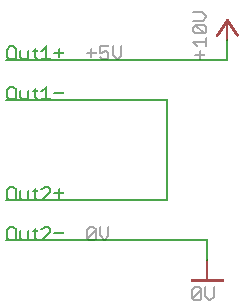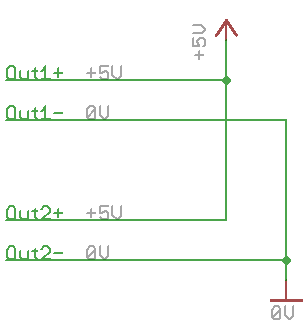Negative voltages: as long as the output is fully floating, you can ground any of the output terminals, which will result in positive or negative voltages. If you want both positive and negative voltages, make a dual power supply (simple case: just build everything twice). If you want to get fancy, you could add auto parallel/series operation.
Ok, let me make sure I understand this right. I can basically build two power supplies, and connect them in series. Then, if I call the middle point(where the two are connected) 'ground', then the negative supply of one of the power supplies is -5 volts, while the positive supply of the other is +5 volts(assuming that both power supplies are set to output five volts) Is that correct? If so, does the following schematic(simplified of course) represent this (conceptually) accurately?

Is it relatively accurate to think of two power supplies as batteries? Putting them in series adds the voltage of the two, while putting them in parallel will keep the voltage the same but allow you to increase the current draw? Do the following represent this?


Amount of current: depends on your applications, there is no universal answer. Motors can draw lots of current, modern uC circuits draw very little. For my own projects, 1A is usually plenty, and I rarely need more than 12V. I do sometimes need 1.2V for some digital circuits, though. But someone into robotics or audio amplifiers will have completely different requirements, and someone into tubes will want a supply that goes up to 300V or so. I consider going down all the way to 0V an essential feature.
I didn't think of it this way. Since I am still learning, I haven't really found an area I like to 'specialize' in yet. However, I can say that I know I will be dealing with motors(robotics and whatnot), and audio circuits at some point, if not in the somewhat near future.
My question is, how do I go down to 0 volts if all the regulators I've looked at(not all that many) must have at least something like 1.2 volts above output voltage to work on?
The design used in most high-quality linear variable voltage/current supplies uses a constant current source to feed the pass transistor/Darlington, with two op-amps (one for voltage, one for current) that can sink this current to decrease the base current, and two diodes to make sure only one of them will be active at the same time. The supply of the op-amps is floating around the output voltage, which helps transient response. A simplified version is shown in HP AN-90B, under constant voltage/constant current (CV/CC) power supply. ELV has a complete schematic, schematics in German are similar to schematics in English . It is somewhat more complex that the design you posted, however.
Thanks for the links. I am reading the app notes about power supply and am learning quite a bit I think...
What makes the HP version simplified? What other 'stuff' would I need?
Is it just for learning, or to save money?
If it's to save money, no, it won't work. I tried designing my own, too, because commercial power supplies are expensive. Then after doing all the design, I realized it will cost more than a commercial unit with the same features.
I am not doing this to save money, solely to learn. (Well, I don't have a bench PSU) I am fine with buying what I need(as long as it's not crazy expensive), because I'd rather learn, than take the cheap way out. Thank you for the heads up, nonetheless.
Look up TI's OPA54x series opamp that can source up to 8A, it has built in current limit where you set it with an external reference. TI's data sheet gives you an example with digital controlled PSU using two DAC's to control the thing. As usual you need a -v rail so that the opamp can swing to 0v output. You give up more bandwidth if you choose the higher current models.
It's about as close as it gets when it comes to an all in one solution at such power and size.
This looks like it might be a nice way to do what I want. If what I said about negative voltages above is correct, how would I get a v- rail, without building two other power supplies, just so this one can work? (sorry for the newbie questions, I just really want to understand it, and not just hope it works, because I followed the schematic and hooked it up right)
The metering is a bit tricky. There are all sorts of traps regarding isolation from the output voltage of your PSU and so on. You can use cheap readily available 3,5 digit panelmeters, the cheap ones will need their own isolated power supply! You can build panel meters yourself using the ICL7106/7107 or you can whip something up using a microcontroller and a LCD module.
My own experience tells me to either use 3,5 digit modules or simple analogue meters. Though good analogue meters are not cheap at all, it is the simplest solution.
Some (no, a lot of) care needs to be taken with the mains side of things, basically good insulation, mains rated cable, plugs, switches, fuses have to be used. Keep all live parts well clear of the secondary side of the supply. Isolate all contacts with heat shrinking tube or cover them to prevent accidental touching. Connect all metal parts of your enclosure to protective earth! A lot of it is just common sense. 230V (or 115V) AC is not something to take lightly. It bites awfully and may kill someone!
What about something like this?
http://www.allelectronics.com/make-a-store/item/PM-122/3.5-DIGIT-LED-PANEL-METER-200-MV//1.htmlWhat is meant when it says 'can monitor own voltage'

Are analog meters naturally better for this application? I prefer some form of digital read out-mainly because I think it is nicer, but if analog is better than, by all means I am not resistant to it.
Thanks for the advice about working with AC! I am, however, quite comfortable working with such voltages, as my father is an electrical engineer, and has always taught me good safe practices for things like insulation, and chassis grounding. However, have basically no knowledge about the actual AC circuitry isolation, like pcb design, or what kind of transformer is needed, etc...
Thanks everybody for your help so far! My goal is to have a nice power supply that will help me with my electronics hobby, while also learning a lot while making it. I am continuing to research and read up about various aspects of things, but still need some help on the above mentioned topics.
Thanks again,
Joshua